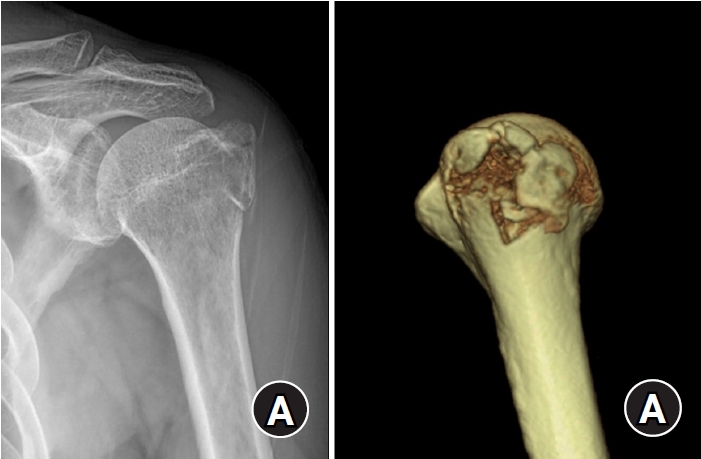-
Outcomes of open reduction and internal fixation using 2.0/2.4 mm locking compression plate in isolated greater tuberosity fractures of humerus
-
Sung Choi, Dongju Shin, Sangwoo Kim, Byung Hoon Kwack
-
J Musculoskelet Trauma 2025;38(1):32-39. Published online January 24, 2025
-
DOI: https://doi.org/10.12671/jmt.2025.00005
-
-
 Abstract Abstract
 PDF PDF
- Background
The purpose of this study was to retrospectively evaluate the radiographic and clinical results of a small single or double low-profile plate fixation of 2.0/2.4 mm locking compression plate (LCP) in treating isolated greater tuberosity (GT) fractures of the humerus. Methods: From June 2015 to October 2022, patients who underwent LCP in treating isolated GT fractures of the humerus were included in this study. The radiological and clinical results were analyzed in 15 patients who underwent open reduction and internal fixation used 2.0/2.4 mm LCP. Results: Bone union was achieved in 14 patients (93.3%) and one failed case was treated with a 2.4 mm single LCP fixation. Radiological union was achieved within 10–20 weeks. Complications occurred in two patients (13.3%), including the reduction failure and shoulder stiffness. At the final follow-up, the average clinical scores were as follows: a visual analog scale for pain of 2.1 (range, 0–5) and a University of California, Los Angeles score of 27.2 (range, 18–31). Regarding range of motion (ROM), the average active ROMs were 142° for forward flexion (range, 120°–150°), 147.1° for abduction (range, 120°– 180°), and 59.3° for external rotation (range, 45°–80°). For internal rotation, the average was observed to reach the 10th thoracic vertebra (range, 1st lumbar vertebra–7th thoracic vertebra). Conclusions: The clinical and radiologic outcomes of treating isolated GT fracture using 2.0/2.4 mm LCP were favorable, and double low-profile plate fixation may be beneficial for sufficient fracture stability if possible. Level of evidence: Level IV, case series.
-
Surgical Outcomes of the Monteggia Type 2 Fracture Dislocation in Adults
-
Sung Choi, Daegeun Jeong, Youngsoo Byun, Taehoe Gu, Sungsoo Ha, Dongju Shin
-
J Korean Fract Soc 2019;32(1):6-13. Published online January 31, 2019
-
DOI: https://doi.org/10.12671/jkfs.2019.32.1.6
-
-
 Abstract Abstract
 PDF PDF
- PURPOSE
This study examined clinical outcomes of Monteggia fracture type 2, which is the most common in adults with a high rate of accompanied injuries.
MATERIALS AND METHODS
From June 2004 to November 2015, a retrospective study was performed on 12 patients diagnosed with Monteggia fracture type 2 with a follow-up period of at least 6 months after surgery. The clinical outcomes were evaluated using the Mayo elbow performance score (MEPS), and the existence of accompanied injures, radiological result, and complications were analyzed.
RESULTS
Posterior instability was confirmed in all patients and accompanied fractures were detected in 9 patients (75.0%) on the radial head, whereas 10 patients (83.3%) were found on the coronoid process. The average arc of motion was 107° (70°–130°) and the mean MEPS was 89 (45–100). Additional re-operation due to re-dislocation, radioulnar synostosis, elbow instability, ulna nonunion, and radial head nonunion were performed in 4 cases (33.3%).
CONCLUSION
The Monteggia fracture type 2 is more commonly associated with radial head fractures and coronoid process fractures rather than other types, which causes elbow instability. Because the rate of additional surgery due to complications is high, the treatment of Monteggia fracture type 2 requires careful assessments.
-
Bleeding Volume after Surgery for Trochanteric Fractures of the Femur in Patients Treated with Antiplatelet Agents: Comparison according to Surgical Timing
-
Se Ang Jang, Young Ho Cho, Young Soo Byun, Tae Gyun Kim, Hun Sik Cho, Sung Choi
-
J Korean Fract Soc 2012;25(2):105-109. Published online April 30, 2012
-
DOI: https://doi.org/10.12671/jkfs.2012.25.2.105
-
-
 Abstract Abstract
 PDF PDF
- PURPOSE
We evaluated the bleeding volume after surgery for trochanteric fractures of the femur in patients treated with antiplatelet agents according to surgical timing.
MATERIALS AND METHODS
We selected 20 patients who had trochanteric fractures of the femur treated with antiplatelet agents from January 2009 to June 2010. Group I included 9 patients who discontinued antiplatelet medication and had delayed operations at an average of 6.5 days and Group II included 11 patients who underwent early operations within 24 hours. Group I included 2 males and 7 females; their average age was 77.8 years (range 59~86). Group II included 4 males and 7 females, with an average age of 73.5 years (range 61~84). We compared the two groups' volume of intraoperative bleeding, the preoperative and postoperative hemoglobin levels and the volume of postoperative transfusion. The Mann-Whitney U test was used for statistical analysis.
RESULTS
The volume of intraoperative bleeding was 88 ml in group I and 106 ml in group II (p>0.01). The difference in the hemoglobin was a decrease of 2.4 mg% in group I and a decrease of 2.2 mg% in group II (p>0.01). The volume of postoperative transfusion was 0.6 pints in group I and 1 pint in group II (p>0.01).
CONCLUSION
We found a similar bleeding volume regardless of operative timing after surgery for trochanteric fractures of the femur in patients treated with antiplatelet agents.
-
Citations
Citations to this article as recorded by  - Is early hip fracture surgery safe for patients on clopidogrel? Systematic review, meta-analysis and meta-regression
B. Doleman, I.K. Moppett
Injury.2015; 46(6): 954. CrossRef - Morbidity and Mortality of the Elderly after Early Operation for Trochanteric Fractures
Se-Ang Jang, Young-Ho Cho, Young-Soo Byun, Ki-Hong Park, Hyun-Seong Yoo, Chul Jung
Journal of the Korean Fracture Society.2013; 26(3): 199. CrossRef
-
241
View
-
0
Download
-
2
Crossref
|








